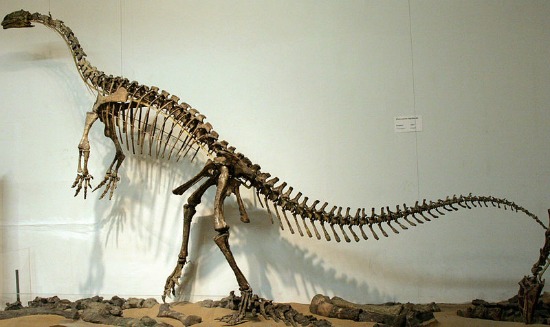Paleontologists Puzzle Over Possible Dinosaur Bones
When did dinosaurs start to become giants? Enigmatic bone fragments found in England complicate the debate
![]()

Partial bone shafts found in Late Triassic rock in England might represent a sauropodomorph, similar to this Plateosaurus, or an entirely different kind of creature. Photo by FunkMonk, image from Wikipedia.
Dinosaur giants are among the most famous Mesozoic celebrities. Yet the dinosaur growth spurt didn’t start just as soon as Eoraptor and kin evolved. For most of the Triassic, the first act in their story, dinosaurs were small and gracile creatures, with the first relatively large dinosaurs being the sauropodomorphs of the Late Triassic. Even then, Plateosaurus and kin didn’t come close to the truly enormous sizes of their later relatives–such as Diplodocus and Futalognkosaurus. Discerning when dinosaurs started to bulk up is difficult, however, and made all the more complicated by a set of enigmatic bones found in England.
The fossils at the heart of the in-press Acta Palaeontologica Polonica study, as described by University of Cape Town paleontologist Ragna Redelstorff and coauthors, have been known to researchers for a long time. During the mid-19th century, naturalists described at least five large, incomplete shafts found in the Late Triassic rock of southwest England’s Aust Cliff. Two of these fossils were later destroyed, but, drawing from the surviving specimens and illustrations of the lost bones, paleontologist Peter Galton proposed in 2005 that they came from large dinosaurs that lived over 200 million years ago. In particular, two of the bones resembled stegosaur bones, which would have extended the origin of the armored dinosaurs further back than previously thought.
Not everyone agreed with Galton’s proposal. The bone shafts could be from as-yet-unknown sauropods, some paleontologists argued, while other researchers pointed out that the lack of distinctive features on the bones were unidentifiable beyond the level of “tetrapod” (the major group of vertebrates descended from fish with limbs, similar to Tiktaalik). The bones came from big creatures–possibly more than 20 feet long, based on comparisons to other fossils–but the identity of the Aust Cliff animals is unknown.
Since the outside of the bone shafts provide so little information about their identity, Redelstorff and collaborators looked to the microstructure of two specimens for new clues. While the histological evidence appears to show that the sampled bones belonged to the same species, the authors argue, each individual shows different growth strategies. One bone shaft came from a slightly bigger, rapidly growing individual, while the smaller bone represents an older animal that regularly experienced temporary halts in growth (visible as lines called LAGs in the bone). Why this should be so isn’t clear, but Redelstorff and coauthors suggest individual variation, differences between the sexes or ecological factors as possible causes.
But what sort of animals were the Aust Cliff creatures? When the researchers compared their sample with three kinds of dinosaurs–sauropods, archaic sauropodomorphs and stegosaurs–and Triassic croc cousins called pseudosuchians, the pseudosuchians seemed to be the closest match. Indeed, while the researchers concluded that the “Aust Cliff bones simply do not offer a good match with any previously described histologies,” the specimens appeared to share more in common with those of croc-line archosaurs than with dinosaurs.
This isn’t to say that the Aust Cliff animals were definitely large psuedosuchians, like the recently named Smok. As the researchers point out, the specimens contained a type of bone tissue not previously seen in pseudosuchians–either these animals were not pseudosuchians, or these pseudosuchians were a previously unknown histology. And, Redelstorff and collaborators point out, the bones might be attributable to a sauropodomorph named Camelotia that is found in the same deposits. Studying the bone microstructure of Smok and Camelotia for comparison would be a logical next step in efforts to narrow down the identity of the Aust Cliff animals. Until then, this early “experiment” in gigantism–as Redelstorff and colleagues call it–remains an unresolved puzzle.
Still, the study highlights the importance of building a deep database of paleohistological samples. Had the researchers sampled just one bone, they may have come to the conclusion that all bones of that type would exhibit the same life history–either rapid, continuous growth or a stop-and-go pattern, depending on which they studied. Together, the bones show variations in the natural history of what is presumably the same species, which brings up the question of how quirks of environment, biology and natural history are recorded in bone. If we are going to understand the biology of dinosaurs and other prehistoric animals, we need to cut into as many bones as we can to understand how variable and biologically flexible the creatures truly were.
Reference:
Redelstorff , R., Sander, P., Galton, P. 2012. Unique bone histology in partial large bone shafts from Aust Cliff (England, Upper Triassic): an early independent experiment in gigantism. Acta Palaeontologica Polonica http://dx.doi.org/10.4202/app.2012.0073
/https://tf-cmsv2-smithsonianmag-media.s3.amazonaws.com/accounts/headshot/RileyBlack.png)
/https://tf-cmsv2-smithsonianmag-media.s3.amazonaws.com/accounts/headshot/RileyBlack.png)